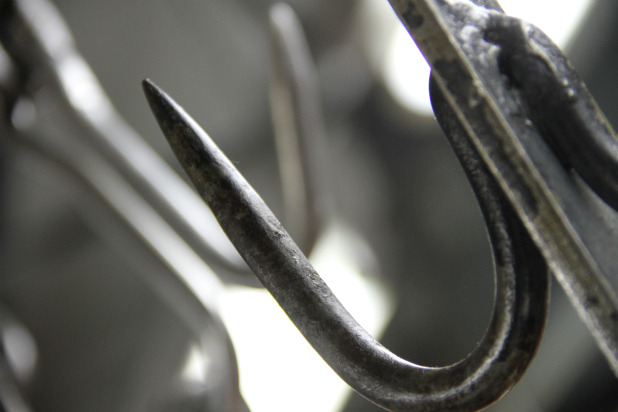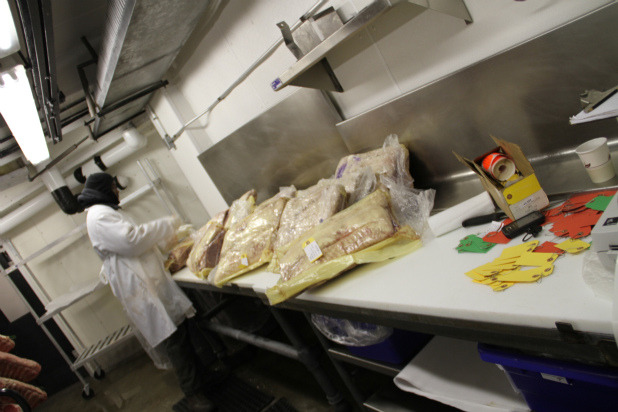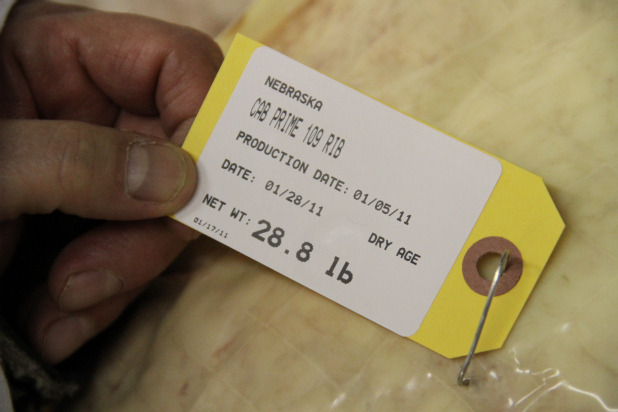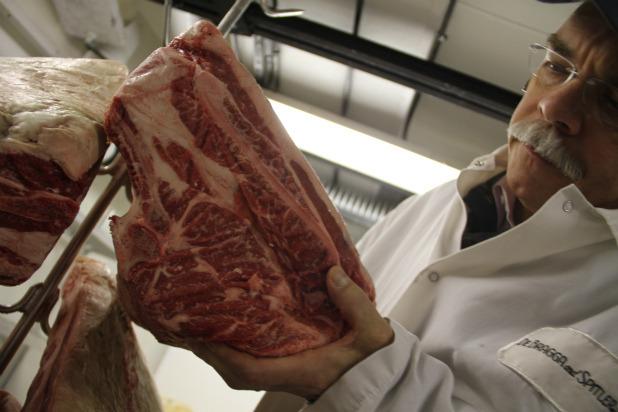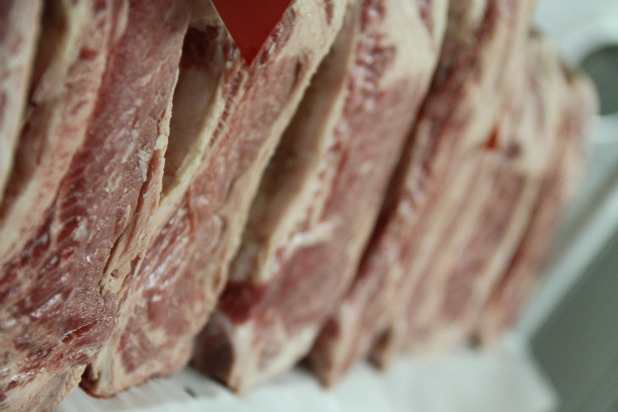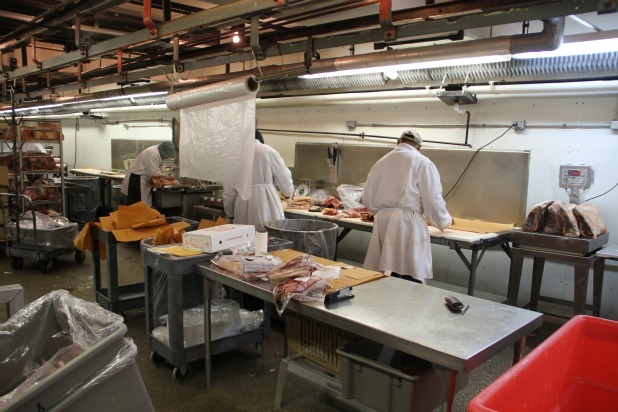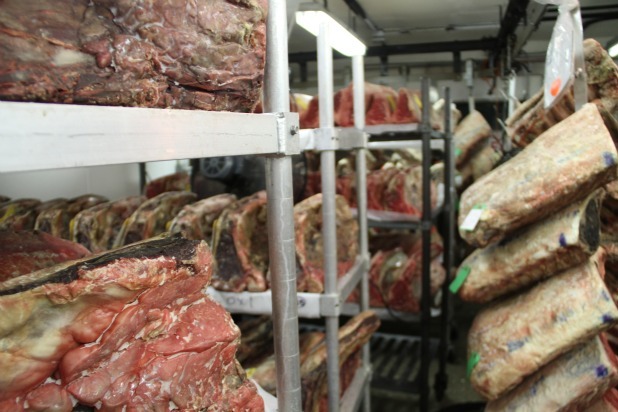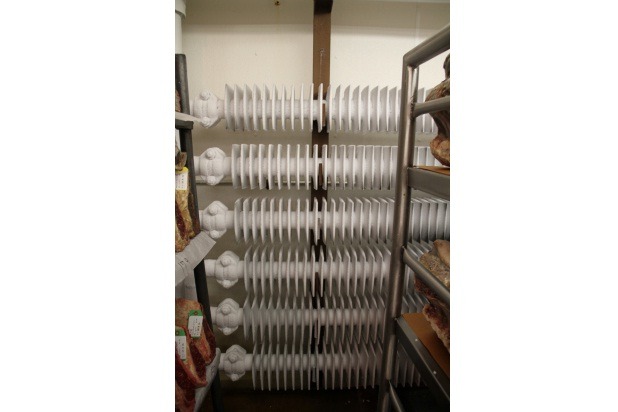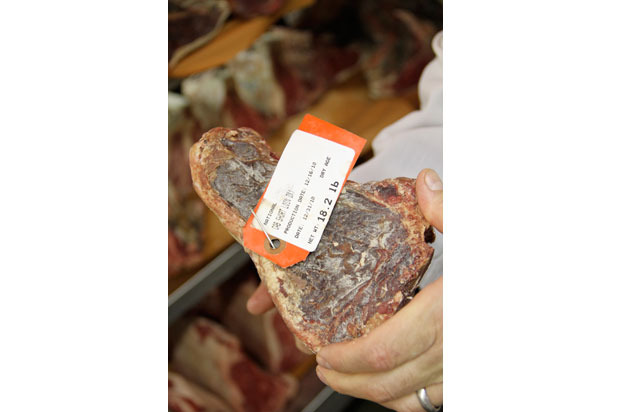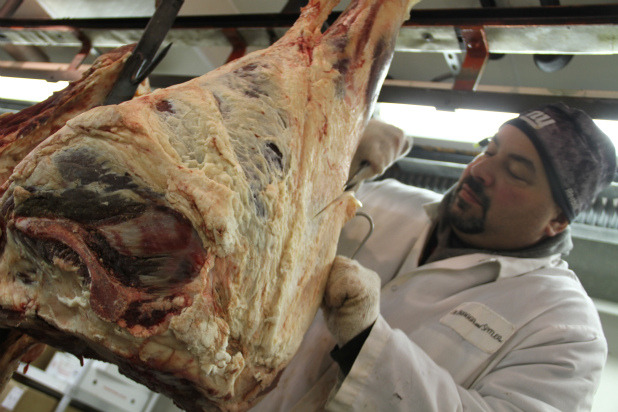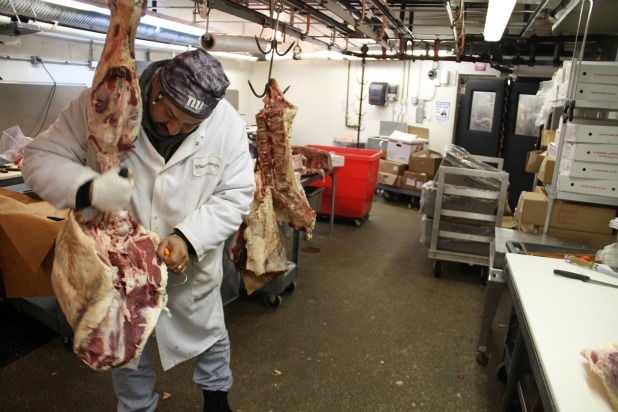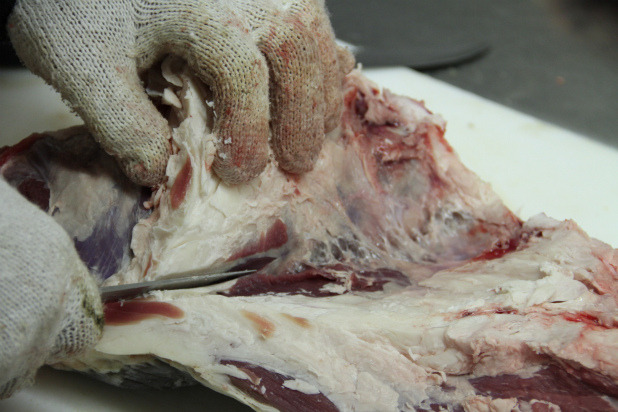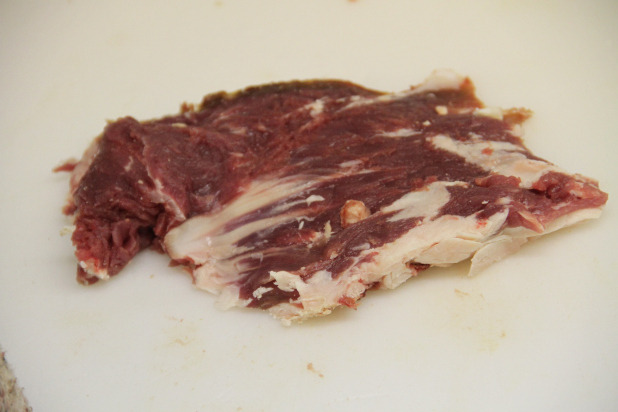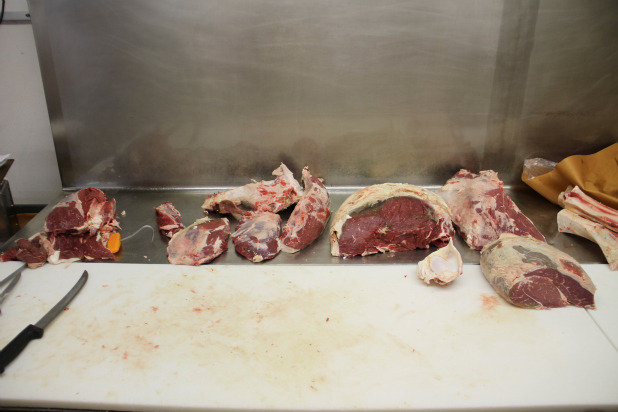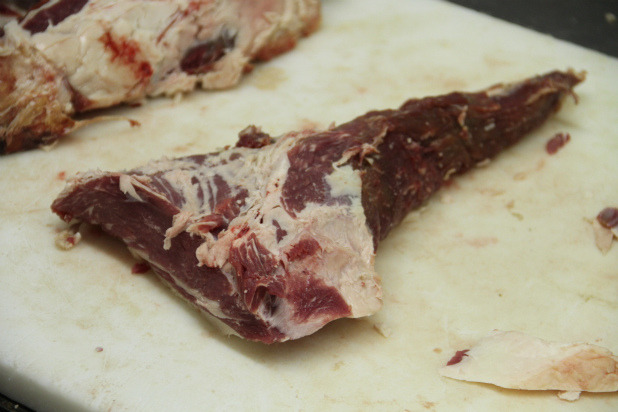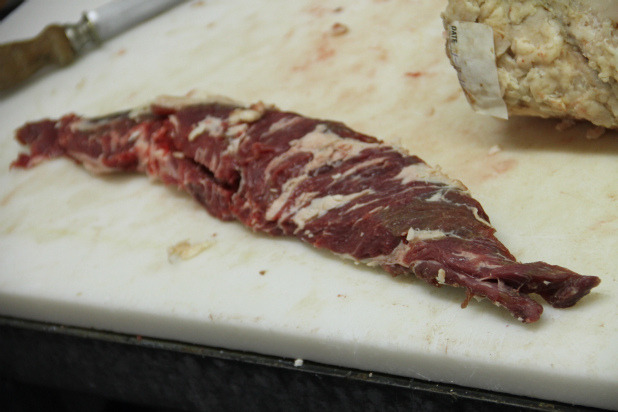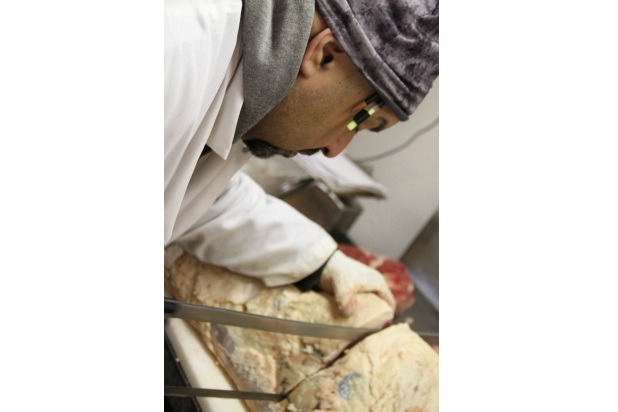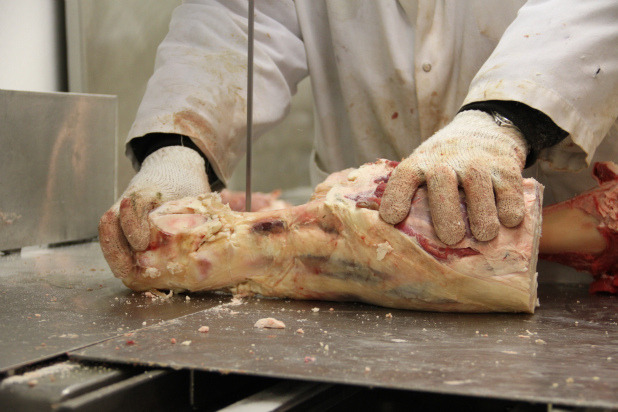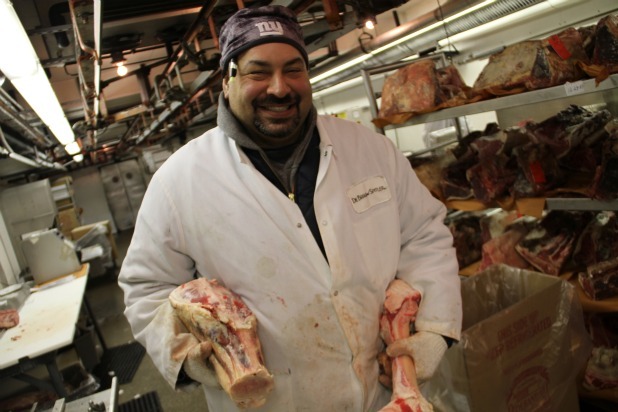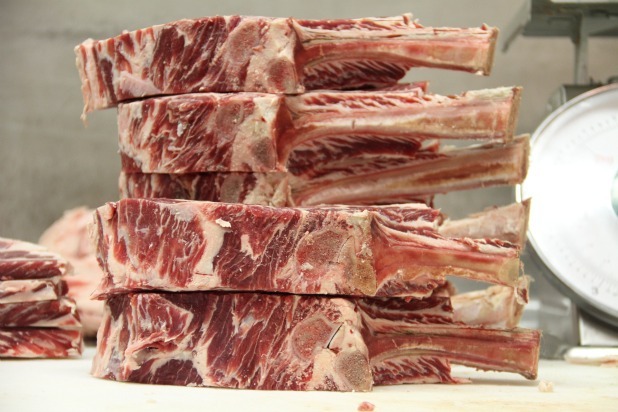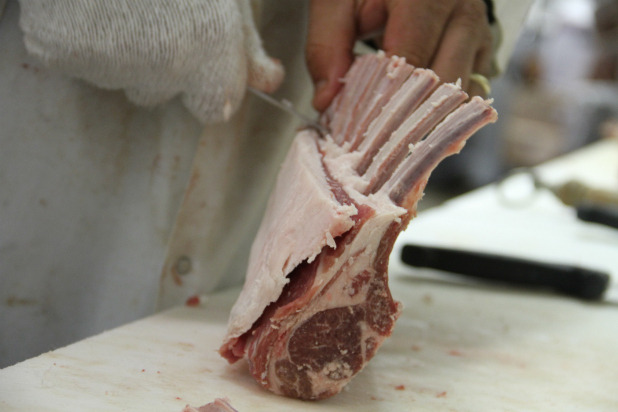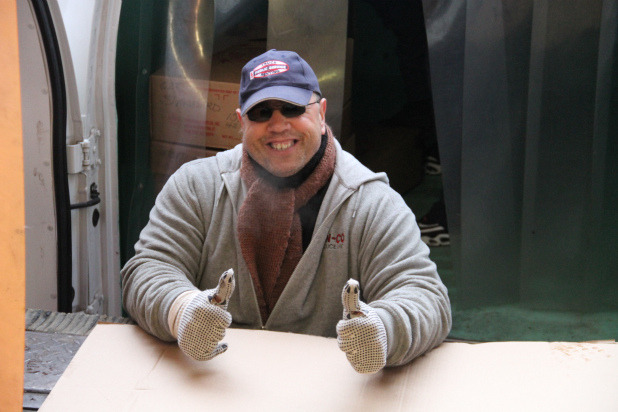A Tour Of DeBragga And Spitler Slideshow
One of the first things you'll noticed at the landing docks at DeBragga & Spitler, is the tracking installed on the ceiling. Originally, animals were hung on hooks in the tracking, enabling them to be more easily be carried within the plant.
Hooks
DeBragga doesn't use this system as it was first intended, but they're still able to hang meat on hooks when they need to, and use them to help butcher whole carcasses.
Inside the Prep Room
In the prep room, an employee puts labels on packaged meat.
Labelling the Meat
Tags show origins of the meat (where it was raised), the type of beef and cut (here, a certified Angus beef prime grade rib of beef, a seven-rib roast of beef graded in the top 1% of beef in America). The label is dated to indicate when the meat was processed, that it went into the dry-aging rooms at DeBragga, and what it weighed when it went in.
Each piece in the dry-aging rooms is tagged this way before being shelved. It guarantees buyers that they're getting dry-aged piece of quality beef. Here, the label shows meat processed on January 5th, and that it went into the dry-aging rooms on the 28th at a net weight of 28.8 pounds. This is important because when meat is pulled to be sold, it will be weighed again, and they'll note how much it shrank (how much water evaporated, concentrating flavor).
George Faison Examines the Marbling
George Faison, the chief operating officer and partner of DeBragga, shows off a gorgeous hunk of beef, with lots of fat running through it, which will make it very tasty once it's been aged (at DeBragga, the standard period spent dry-aging beef is 28 to 35 days). This piece has not been tagged for dry-aging yet. As you can see, the meat is red, and there is no funk anywhere on its surface.
Dry-Aging
Inside the dry-aging room are shelves filled with beautiful shortloins. This one holds meat that are new to the room — the color of the meat is still a rich red and not the faded, brick-colored red that the hardened exterior develops as the meat ages.
Once aged, shortloins will be trimmed and butchered by hand into strips and T-bones, and sold to restaurants in the greater New York area, or go to consumers who have ordered them at DeBragga's online store, which according to the company, sells more dry-aged beef than anything else.
Butchering
The butcher's room in DeBragga is a hub of activity whose action starts around midnight and goes at full-tilt until 2 p.m. The 14 hours in between is broken into two shifts. Butchers hand-trim and cut the meat, turning shortloins and ribs into steaks and chops, tenderloins into filets, and the like.
On the right you can see four shortloins waiting to be trimmed and the DeBragga box in the center of the table where they'll be packed. It takes precision and care to break down the meat — each piece is cut, weighed and cryovacked to keep out the air and keep the meat fresh. After diligently breaking down the meat, butchers clean every surface in the rooms.
Dry-Aging Room
Temperature and humidity in the dry-aging rooms are controlled to provide the ideal atmosphere for the process. It's pretty cool to inhale the scent and see how meat transforms as it ages. The surface tightens and hardens as water evaporates, making the fat and meat more dense and concentrating flavor. As the meat ages, an enzymatic transformation makes it tender and gives it the funky, beefy flavor that lovers of dry-aging appreciate.
Dry-Aging Coils
DeBragga uses a brine refrigeration system, whose cooling coils you can see here covered with frost, exactly as they should be.
Dry-Aged Shortloin
You can tell this certified Angus beef shortloin has quite a bit of age on it from the scabbing on the exterior (it's also clearly not 18.2 pounds any longer). It will be trimmed of the rough exterior, then butchered into steaks.
Breaking Down the Beef
Robert Chopak, DeBragga's head butcher, breaks down a round of grass-fed beef.
Using the Hook to Break Down the Beef
Chopak uses the hook to help him balance the quarter as he cuts the muscle free from the bone. Currently, DeBragga sells grass-fed beef raised in the Finger Lakes of New York by Rosenkrans Farms. New York's butcher has moved from selling quarters to chefs to creating a boxed beef program.
Trimming the Fat
Larger cuts are portioned into steaks, ribs, chops, tenderloins, roasts, and ground beef. The room is cold but Robert's hands are steady as he expertly portions out steaks quickly and deftly.
Portioning
"Chefs are looking for good, clean meats and poultry that they can afford to put on a plate and sell," explained Marc Sarrazin, partner an President of Debragga. "By good and clean, we mean 'never, ever' using meats and poultry that have been given hormones or antibiotics, never fed animal byproducts or any artificial feed. And by the way, the federal government prohibits the use of hormones in poultry and pork, so any time you see that on a package, you know it's just blowing smoke."
The Finished Result
It takes Robert just about 15 minutes to complete the whole process of breaking down a hindquarter of grass-fed beef from Rosenkrans Farms into various cuts. From left to right, these cuts are the three parts of a top sirloin (grande filet, petite filet, culotte), a sirloin flap, and a tri-tip.
Tri-Tip Steak
A tender and delicious cut of grass-fed beef, the tri-tip is best cooked rare to medium rare, rested for at least five minutes, and sliced to serve. Check out this great recipe for cooking tri-tip.
Strip Steak
"Now, naturally-raised, good clean ingredients are not always compatible with affordable pricing," Marc Sarrazin explained. "So DeBragga works with chefs to help them see that a portion of the cost is actually reasonable. The chefs buy from us by the pound, but they are getting a certain number of portions from a pound, and they need to look at it that way. Chefs also want to know where the product comes from these days: growers, growing methods, and what are the impacts to our human health, the animal's welfare, and our planet."
Using the Butcher Saw
It's a large animal, and it takes a sturdy saw to cleanly separate the shortloin of grass-fed beef into steaks.
Bandsaw
In contrast to the handsaw, by using the bandsaw, Robert is able to quickly and cleanly cut through bone and sinew with little effort.
New York's Head Butcher
If DeBragga's slogan is New York's Butcher, and Robert Chopak is head butcher at DeBragga, well then, he's New York's head butcher.
Frenched Rib Chops
This stack of Frenched grass-fed rib chops are cleaned of sinew and bone, leaving them with a clean and beautiful appearance. The rib chops each weigh about 28 ounces.
Frenching a Rack of Lamb
Robert Frenches a rack of ribs, leaving the bones clean.
Delivery Driver George Gonzalez
After the meat is portioned, labeled, and packed up, it's sent out to hundreds of chefs around the city and to restaurants and customers all over the New York area. Delivery Driver George Gonzalez helps make that happen. Here, he gives two thumbs up while taking a break from loading up his truck.

